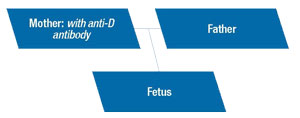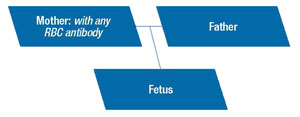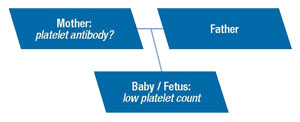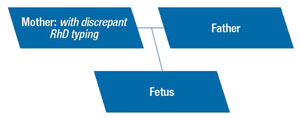Transfusion Services
Perinatal Testing for Optimal Care
Diagnosing Fetal Risk of HDFN and NATP
Why test?
Hemolytic disease of the fetus and newborn (HDFN) is a life threatening complication of previous pregnancy or transfusion when maternal red cell antibodies cross the placenta and cause fetal hemolysis.
Neonatal alloimmune thrombocytopenia (NATP) is similar to HDFN when maternal platelet antibody crosses the placenta and causes low platelet count in the fetus / newborn, increasing the risk of bleeding.
Using the latest genetic and antibody specificity technology, the mother, father and fetus can be tested to predict clinical risk of both HDFN and NATP.
Genetic testing can also resolve serological assignments of weak RhD (weak D) in pregnant patients to determine blood type and help with Rh immune globulin decisions.
Testing options
Predicting risk for HDFN
For a mother with antibodies to RhD (anti-D), genetic testing determines if the father carries one or two copies of RhD gene (zygosity) to gauge fetal risk of “Rh disease.”

When a mother has a red cell antibody, the risk of the fetal expression of the red cell antigen is determined from testing samples from the mother, father and/or fetus. In these cases, genotyping the fetal cells can directly determine if there is incompatibility. Paternal testing can determine the risk of fetal incompatibility.

Diagnosing and predicting risk for NATP
When a baby is born with a low platelet count, antibody and genetic testing determines if a maternal platelet antibody is the cause.
When a previous pregnancy was affected by NATP or the pregnancy of a mother’s female sibling was affected by NATP, genetic testing determines if the current fetus is at risk.

Determine maternal RhD type
When weak D is present, genetic testing of the maternal sample is used to determine weak D blood type.

Your Specialty Consulting Team
- Meghan Delaney, DO, MPH: Medical Director and expert in red cell genotying for transfusion medicine; Board certified in transfusion medicine and clinical pathology. Read her bio.
- Terry Gernsheimer, MD: Medical Director of Platelet Immunology; Board certified in hematology, an international expert on platelet transfusion and immune mediated thrombocytopenia.
- Gayle Teramura, BS: Manager of Hemostasis Reference, Platelet Immunology, and Genomics Testing laboratories.
- Karen Nelson, PhD: Laboratory Director, SDL; Board certified in histocompatibility and immunogenetics.

